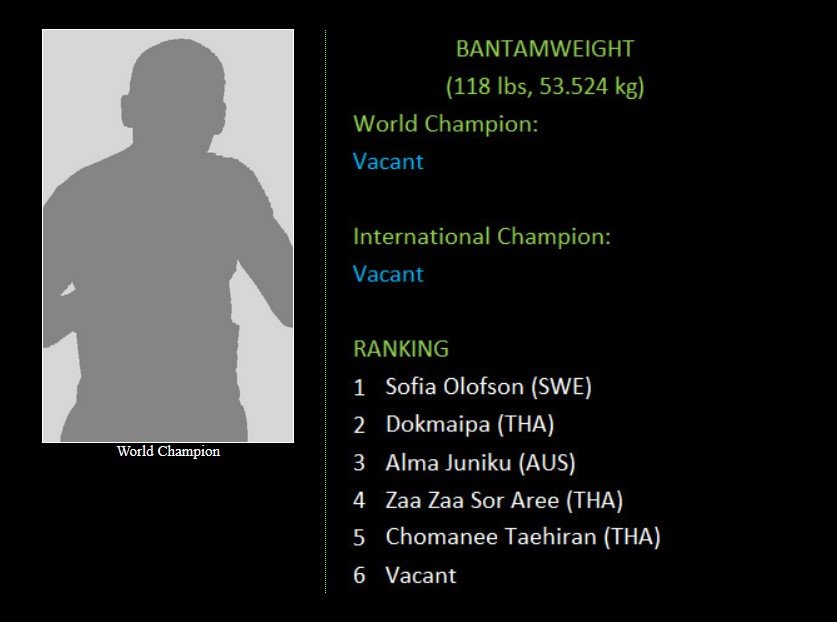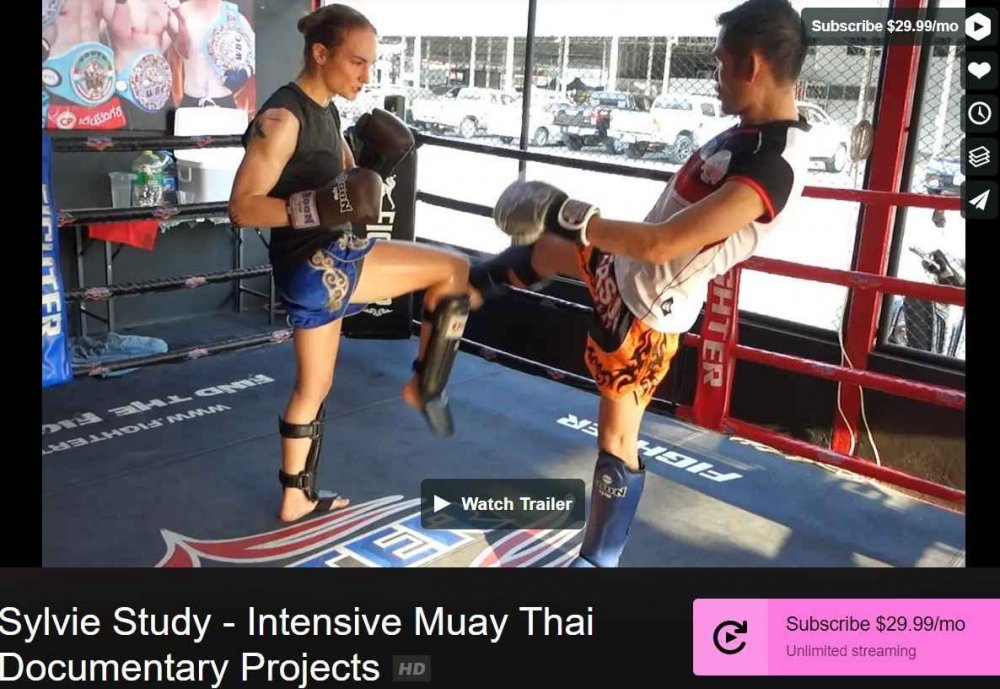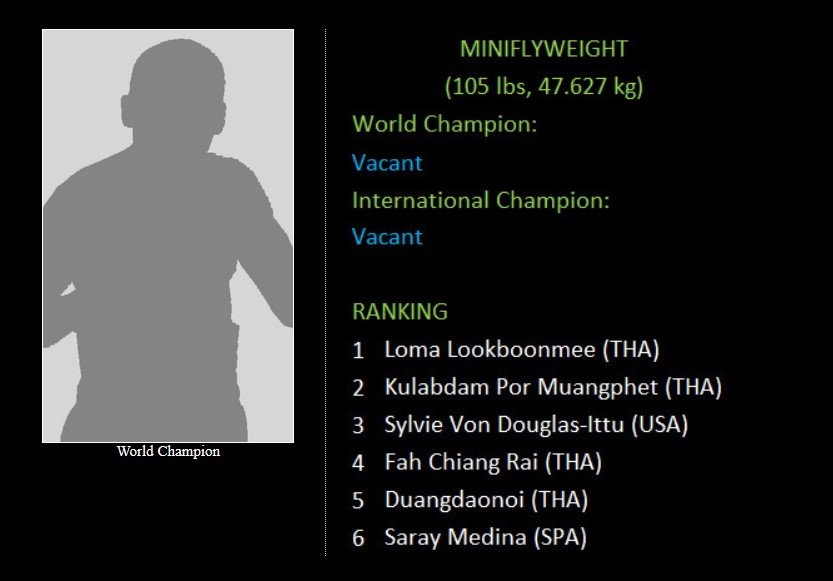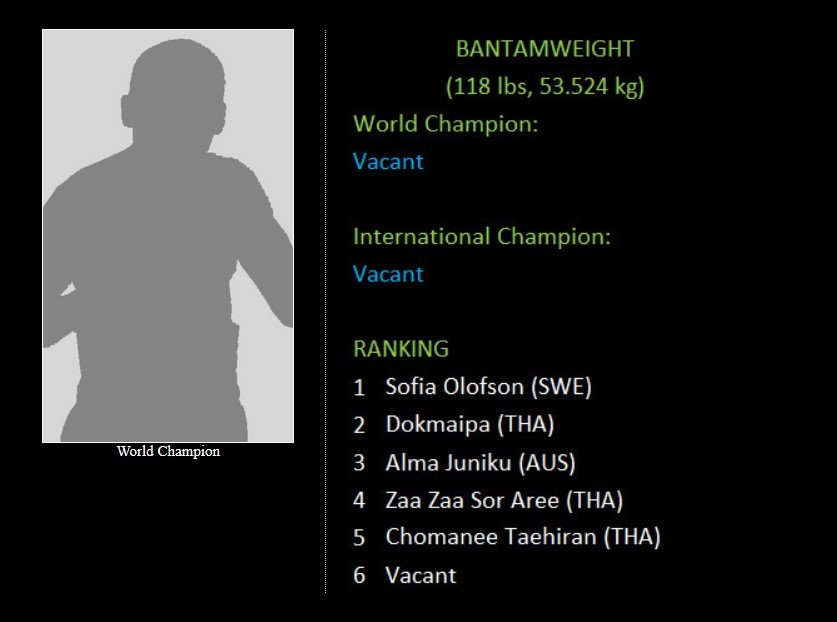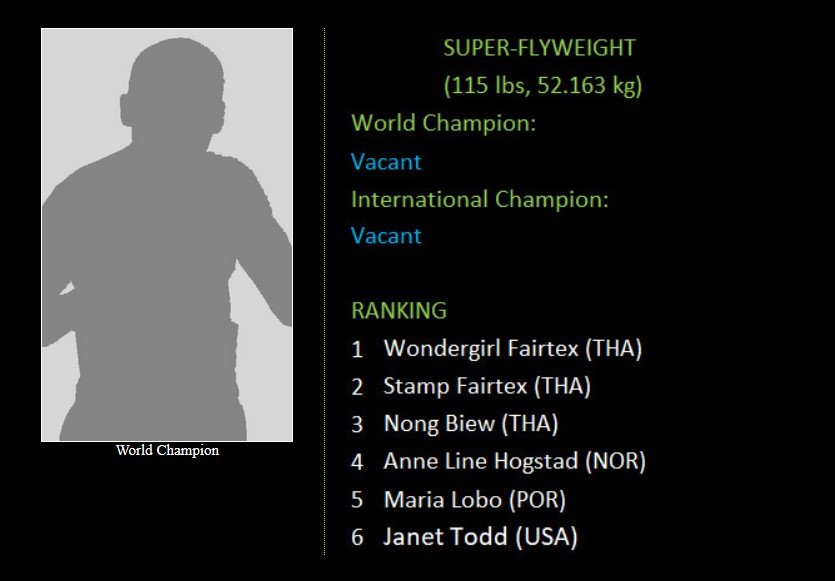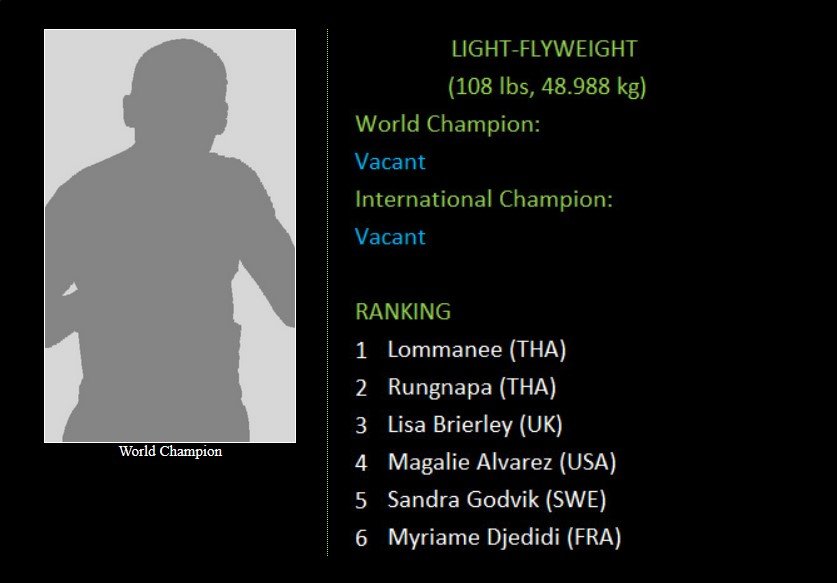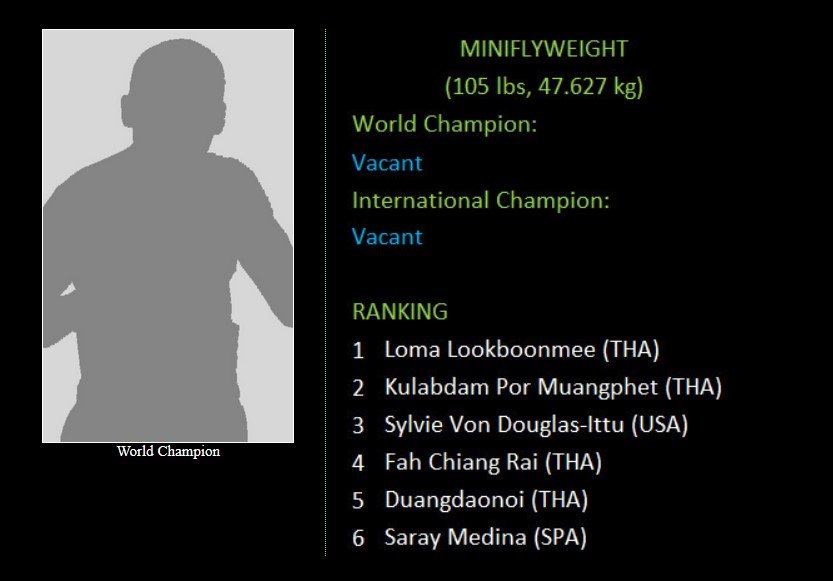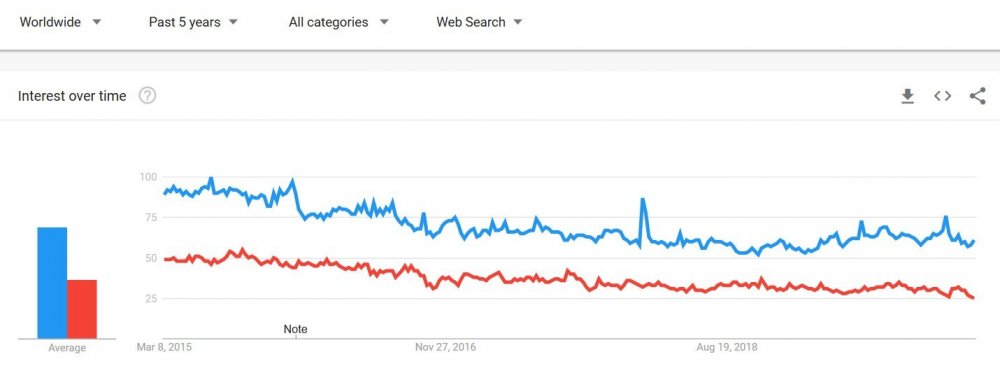-
Posts
2,264 -
Joined
-
Days Won
500
Everything posted by Kevin von Duuglas-Ittu
-
I mean, orgs sometimes make p4p rankings to generate excitement, so I guess there could be that, but that is not necessary. But in Sylvie's case, if you have beaten the #1 ranked fighter 2 weight classes up, you probably shouldn't be ranked #3 in your own weight class... Being able to beat bigger, ranked opponents is a sign of skill and dominance. I don't really blame the WBC though, it's almost impossible to keep track of so many fights. I'm sure nobody knew that she had beaten the #2 fighter in her own division either.
-
Wow, thanks for the fill in! Exactly what I was hoping to hear. Seems like they peppered in some notable names from the past in some of these divisions, which I suppose is to be expected when a ranking first begins. This is a hard division. Sofia is definitely a top fighter on anyone's P4P list. So yes. And I've mentioned my appreciation for Dokmaibaa and Alma. Zaza, honestly, is just a big name from the distant past. She hasn't beaten anyone top ranked, who actually weighs the same, in a very, very long time, as as I know. You can see in this fight between her in Alma 1.5 years ago the huge distance between them in skill and readiness (watch it here): Zaza is much more a "name" that derived from her attractiveness and her early World Title at the age of 14, a long time ago. It's just my opinion, she's a tough fighter, but isn't really a World Class fighter at this weight. She also lost to a much, much smaller Lisa Brierly who is ranked #3 at only 49 kg, several weight classes down. Hey, every ranking probably needs names and figures, and given that the rankings for this division have a vacant spot, maybe they were happy to put her on there. As to Chommanee? Oi. Literally one of the best female Muay Thai fighters in the world a few years ago, had mixed success in Glory kickboxing. But the real truth about her is that she probably hardly trains. I mean, she likely trains before fights, but I think she's just one of these very top Thais who really does not stay in regular training. It's one of the hardest things of ranking top Thai fighters. In terms of talent and skill, they are 9s or 10s. In terms of calluses and fight-shape, sometimes 3s or 4s. They've been fighting since they are like 8 years old, so it is in a way understandable that their drive into their mid-twenties just isn't the same. I mean, she deserves to be ranked, but who knows how much. I just don't know the European fighters high up on the Featherweight list. Sawsing is caught somewhat in the same boat as Chommanee. I means, she's much more fight ready since she's taken on the Superchamp promotion responsibilities in Thailand, and of course beautifully skilled from years of competition, but it's unclear if she's growing as a fighter. I'm ok with her at #4, though if she were fighting a lot, and in the gym all the time, I could see her beating anyone in her weight class in full rules Muay Thai, in the world. She really is an excellent fighter.
-
With the help of Dave Jones who is helping us all with tech support and design, kind of sponsoring Sylvie through his efforts, we've been able to relaunch the Store on Sylvie's 8limbsus site, and have started filling it with some awesome stuff. You can find it here: Sylvie Store. You'll find not only Sylvie shirts and shorts (which help raise money for the Kru Fund, but also Karuhat merchandise that goes completely to supporting him, and other awesome stuff like the first documentary made on Sylvie. Time to check it out.
-
Patreon just keeps getting better. One of the difficulties with Patreon was that Sylvie just had so much post. This is a good thing, but scrolling through looking for stuff was a pain. Patreon has now added a Search Bar so titles can be searched for by keyword. And, the Table of Contents of the Library is now pinned to the top of the Posts Tab, which you can find here. It all looks like this: You can also see that there are also tags for searching through the vast material. Always getting better. Here is a screenshot of the Sylvie Study Intensive as well:
-
That is going to be the bloody-hell hard part. There are just so many rates of change. And information funnels through very specific channels (how could it not). I can't imagine the process that could keep this updated across continents, but damn it's impressive that they are trying. I was a pretty big fan of the lower-weight WPMF rankings, until I realized that they just adjusted the top fighters when there was a fight for a belt, and left the rest unchanged, like forever.
-
Sylvie's list of recommended gyms: It's probably best to go to a thriving gym with lots of westerners training, a place like Hongthong Muay Thai in Chiang Mai (which still has fighting opportunities), or if you like something smaller, Manop's Gym in Chiang Mai. If you want to fight Chiang Mai is a solid place because there are so many stadia, and unless you are very large they should be able to match you up, if you express a desire to fight.
-
Other interesting, or possibly questioned rankings are Lommanee at #1 at 108 lbs. I've ranked Lommannee very high, as high as being possibly the best in the world,, at some point. But she had a huge showdown fight vs Amy Pirnie, and lost. And then fought a kickboxing fight in Japan against someone distinctly smaller, and only came away with a draw. She hasn't had a big win against elite talent in a long while, so it is is maybe hard to put her at #1. This being said, she, like Loma, has been the Queen of her weight class for a long time, so maybe deserves to start out there. Also, poor Amy Pirnie. She beat Lommanee in a big fight and kind of didn't get a lot of recognition for it. She has such explosive, beautiful Muay, but is only ranked #4 at 112 lbs. If I had to put my money down, I might take Amy against anyone in that division. I LOVE seeing Dokmaibaa ranked #2 at 118 lbs. It's just amazing to see a talent like her recognized. And it's very cool to see Alma at #3 right behind her. That would just be a great fight to see right now. Two female fighters as good as you might want, right next to each other in the rankings.
-
. Because we all come from this from our own little fishbowl - even though Sylvie's fishbowl is larger than many others, it's still a fishbowl - the most interesting thing to me is the 105 lb division. 105 is the lowest weight the WBC can go at this point, but several of the fighters there are actually 100 lb fighters properly. #1 Loma reigned as the best 100 lb fighter for many years. #2 Gulapdam, I believe, holds the 105 lb WPMF title, but she legit is more a 100 lb fighter. #3 Sylvie walks around lighter than 105 lb, and could fight below 100 lbs. #4 Faa Chiangrai definitely is a 100 lb fighter. #5 Duangdaonoi historically had been able to reach 100, I'm not sure about now. I don't know #6. It's safe to say, almost the entire ranked division is more a 100 lb division, which is pretty cool. That means that there is some serious 100 lb talent out there in the world. As to the rankings themselves, there are a few question marks. The first of course is Loma, who definitely deserves the respect for her years of high level supremacy. She was unequaled. But...she doesn't seem to be fighting Muay Thai any longer. Her last big fight, that I recall, was a disappointing loss in an early round at IFMA, but most importantly, she says she walks around now at around 57 kg (125 lbs), and has expressed an earnest desire to put on even more weight. She's had to almost entirely change her body just so she can compete at UFC straw weight, which has some VERY big fighters. She really, as a fighter, isn't close to being able to compete in her former stomping grounds. And, given that her career path is in MMA, she really lacks financial incentive to do so. This isn't something to hold against her. But...how long would she properly be thought of as a 105 lb fighter? It might be better to think of her as one of the best 112 lb Muay Thai fighters in the world? Maybe at some point. Be that as it may, her beautiful superiority at 100 lbs for so long really does grant her leeway in this. She deserves to start out as Queen on top. How long she remains there in an up to date ranking is another question. As to #2 Gulapdam, the only quibble I would have is that the one time Gulapdam and Sylvie fought, a few years ago, Sylvie really owned that fight in a pretty distinct way (TKO, if I recall, with Gulapdam's corner throwing in the towel). So clear was the win that we really got the sense that a rematch wasn't something of interest at all to her camp. After that fight whenever a match up with her representative in the North was booked it wasn't Gulapdam who Sylvie faced, but rather the much larger and super skilled Thanonchanok (#3 at 112, above). it's actually a really good tough match up. Sylvie at 100 lbs was being booked vs a 112 lb champion, instead of the more natural 100 lb Gulapdam, by the gym that handled both fighters. You can see Sylvie pretty much overwhelming Gulapdam, a couple of years ago, here (Sylvie Petchrungruang vs Kulapdam Por Muangphet). No doubt both fighters have improved since then. I'll also say that Gulapdam is one of Sylvie's favorite fighters, and a really under recognized talent. It is very cool for her to be up at #2, I'm pretty happy with that. As to #3, Sylvie. Well, it's Sylvie. I'm always of two minds on Sylvie in rankings. I'd prefer, all things being equal, for Sylvie just not be in the rankings. I like her to be an underground fighter because her progress is one of those incredible slow burns. And being ignored or underhyped actually is what is best for the long term process. Hyped fighters end up not fighting very frequently at all in Thailand. On the other hand, just thinking about Sylvie's position in the 105 lb rankings, making her case, something has to be said about all of her success fighting WAY up in weight, in fact multiple weight classes up, something no one does to the degree that she does. Point in fact, the WBC #1 ranked 112 lb fighter Pornphan, who is tearing up Thailand right now, lost to Sylvie about 2 months ago. You can see that fight below: So you have the #3 ranked WBC 105 lb fighter beating the #1 ranked 112 lb fighter It was a close fight, and little publicized, but damn. Going up two weight classes to fight the best there, and winning, that's a notch in your belt, especially as a 100 lb fighter. This being said, Pornphan an awesome fighter, and huge props to the WBC for recognizing a rising talent like her. These are exactly the kinds of Thai fighters that are hard to pick up on your radar, from afar. In Thailand fighters like this just shoot up. Extremely complete fighters, full of experience and skill at every range. Sylvie's a difficult fighter to rank at 105 because she's had so much success fighting up. She pretty much controlled the currently ranked #2 fighter at 108 lbs, Rungnapa, when they fought a series of fights a few years ago, beating her 3 of 4 times despite giving up the weight. Sylvie's has beat the much respected #3 ranked 112 lb fighter Thanonchanok twice, once just 6 weeks before Thanonchanok flew to Japan to win a World Title, despite the weight (though Sylvie has lost the series between them). And she fought Wondergirl Fairtex, the #1 115 lb fighter in the rankings, in a very close fight that many in attendance thought Sylvie had won. You can see that fight here: Sylvie Petchrungruang vs Wondergirl Fairtex. Notably, Faa Chiang Rai ended up beating Wondergirl in that tournament, also giving up big weight. What is insane about Sylvie is how much she's fought the top fighters in weight classes so far above her, all the way up to ranked 118 lb fighters. #4 Faa Chiangrai. Yes, just a wonderful fighter. Sylvie and she have faced off several times. Sylvie took the edge beating her 3x in a month, and winning the Northern 105 lb belt in her hometown of Chiang Rai a few years ago. But...she has really improved, and has frankly been on the short end of some high profile international fights. She deserved to win vs Saya Ito for the 100 lb WPMF belt (I believe), and was kind of hometowned in that fight. She properly is a world champion, maybe several times over. #5 Duangdaonoi. Properly recognized. She too could probably fight at 100 lbs. Had a rough time defending her WPMF 105 lb belt in Japan where she was just overmatched in size, a few years ago. Has had some success in boxing. I believe won a title. Sylvie and she had a very memorable fight a few years ago. Sylvie kind of ragdolled her, winning, but Duangdaonoi opened up a huge cut on Sylvie in a very bloody end. #6 Saray Medina. We live in Thailand so haven't been as exposed to western fighters at this weight. I'm not familiar, so this is really on my ignorance. maybe the Belarusian fighter Alena Liashkevitch who has beaten Loma in IFMAs at 45 kg deserves to be on the list...if she is still fighting?
-
Let me just say, there has been perhaps no bigger setback for female Muay Thai than the lack of serious, regularly updated, multi-national, truly "world" level rankings. The WPMF site was trying hard many years ago, but it was drawing from a very small knowledge base, and it was practically impossible to keep up to date, especially given the shifting sands of Thailand's fighting. Lots of fighting. Finally they just gave up with the difficult endeavor. So the new WBC rankings are, right from the start, a huge leap for pretty much everyone. The weighing question really is, can it be kept up to date? Damn, I don't know. It's just a very difficult thing. But, this first release collection is amazingly good. Full of variety, coupled with strong and often suitable acknowledgement of Thai female talent. I'd also say, one of the most important things about rankings isn't that you got it JUST right. It really should be about creating conversations and comparisons. Even debate and criticism. It's about getting people to not just care about the few fighters they know, but also other fighters. To familiarize oneself with the accomplishments of the many. Some of the discussion that follows is in that spirit. We don't have to get it right. Let's just keep it in the mix. But, let's also talk about getting it right too. You can find the updated list on the WBC website here: Female Muay Thai WBC Rankings. But, I'll paste the rankings down below for convenience. If you have thoughts on who should be where, that's a cool thing, let's share.
-
- 50 replies
-
- 1
-

-
Skateboarding (blue) vs Muay Thai (red) 5 years worldwide As to something like Muay Thai dying, because so much of at least Thailand's Muay Thai is dependent on an entire ecosystem of fighting culture and tens of thousands of fights a year, it may not "die", but it may either become indistinguishable from something it is not, like Kickboxing, or worse, could one day become something preserved in kata-like captures, quite divorced from real fights.
- 50 replies
-
- 1
-

-
Both of these are probably true. If it's a tourist-y gym, probably much more the later. You can write a very respectful email and apologize, thank them very much (if they read English well), and let them know how much you appreciate them. This kind of message can go a long way, though in email, I'm not sure it would matter. In short, the best thing in circumstances is to just communicate your respect.
-
Sounds like it could screw up your visa. If you are concerned about that you are probably stuck. If you arranged with them to go there long term, they vouched for you, and you have been there before, it would seem like a few extra tourists isn't too much to push through. But...this is why I almost always suggest not making long term arrangements with gyms in Thailand. Gyms always are changing, even good ones.
-
This is one of the dilemmas of what we are thinking about. Muay Thai is actually dying off, in a way, in Thailand. It no longer is the case where we can just insulate, and not worry about whatever versions of Muay Thai are out there in the world because Muay Thai is safe and sound in Thailand, thriving. Like you say, MAX, Superchamp, or whatever other hybrid show in the country are powerfully undermining and in fact erasing much of what Muay Thai is, in Thailand. There seems to be some sense in which non-Thais might play an important role in actually preserve Muay Thai, as passionately interesting outsiders...simply because they care about Muay Thai, in a historical sense, while the Thai marketplace really doesn't. It's westerners who attend these large Muay Boran, or Nai Khanomtom Day respect events (whatever we make of them), not Thais. The question is: What role do westerners, or just non-Thais, have in preserving Muay Thai...and are their modes of popularity that could work towards its care.
- 50 replies
-
- 1
-
-
I would suggest you move around. Pick out 3 prospective gyms from what you find online. Then go to each gym at least once, so you can feel the vibe, how comfortable you are. Compare them. Then pick the best of those 3, and revise your opinion several weeks in. Because you want the cost to be low, but lots of other bonuses, it's probably going to be hard to find Baby Bear on this.
-
Oiii. This really hit me hard, as an American. In terms of digital search footprint in the United States Muay Thai is essentially Krav Maga, which is really incredible...and disappointing. In the last 3 years Krav Maga has slipping in popularity, but in terms of overall level of popularity, surprisingly, not that much difference.
- 50 replies
-
Popping in to update some of the data, as I've been following this for 5 years now. BJJ vs Muay Thai World Wide, holding steady since BJJ surpassed Muay Thai in the Winter of 2018 In the United States, the separation is holding The argument goes that BJJ is a pretty interesting sport comparison as both it and Muay Thai are niche fighting disciplines parasitic on the UFC and MMA in general, which both require specialized knowledge with some sense of cultural celebration of origin.
- 50 replies
-
- 1
-

-
These are all beautiful things. I only took issue with the assumed obviousness by which Lethwei claimed superiority and antecedence to Muay Thai. These things don't seem obvious to me at all, and kind of loaded questions. I do seriously appreciate how firmly you are on the ground on this, how close to the sport and training that you are, and that you took the effort to post such a very cool photo and message. It's so cool that you are throwing yourself into Lethwei, and experiencing it first hand. No need to edit at all! Discussion is good. I find much of the Lethwei messaging problematic on some of the levels I've mentioned, and kind of push back on it when I can, only because nobody seems to be doing so, and it feels important. *I only edited your title because we try to have titles that capture the main subjects under discussion, it helps people know what's in a post, so I added a few keywords.
-
I don't really Google these things, but to be honest much of this "purer" than Muay Thai story seems very ideological, the attempt to lay claim to some forms of supremacy over the Muay Thai of Thailand. First is the claim that it is more brutal (ok, they allow headbutts or KO recoveries, not something you could probably allow in a country with 50,000 fights a year like Thailand), second the claim that is older in some way (I've never really seen an historical evidence that it is the origin), and I can't really take what LeDuc says seriously. He is a pretty much made up media brand image, to be honest about it. I love how successful he is at what he's done, but he really was a Tiger Muay Thai reality show winner before becoming the best Lethwei fighter in the world not long after, and spokesperson for the sport. A more serious question, at least for me, is how much Lethwei is being used as a political tool, perhaps a part of a Sportswashing effort in a country facing some pretty serious human rights violations. It seems clear that LeDuc is being supplemented by the Myanmar government, I mean, his wedding was broadcast on National TV apparently. He's basically a political figure, making political points, but in ways that we from the west have almost no sensitivity toward. I'm not saying that Muay Thai is not used politically in Thailand, it definitely IS, and has been for a century if not longer, but because of that ideological dimension we probably should step carefully regarding a historic foe claiming superiority over the very same politicized element. I don't really know where this claim flows from. The 2nd oldest historical evidence of Muay Thai is the fabled story of Nai Khanom Tom (late 18th century), in a handful of verse lines in an epic poem, telling of how - I'm sure you know the story - he cleaned up against a host of the best Burmese fighters. I'm pretty sure, and it's been a while since I read the source material translation, this story is from a Burmese epic, told by the Burmese, not the Thai. It would seem weird to think that Lethwei, historically, somehow supersedes Muay Thai in a fundamentally important way. But...I definitely would be open to any historical evidence.
-
There is a seriously long, as in centuries long, political animosity between these two countries, intense hatred, and the symbolism of Muay Thai as a national identity and pride plays a really important part of this. It isn't just "some people", its generations of belief. Where do you get this story of origin, I'm curious? My suspicion is that claims like this tend to be ideological in basis.
Footer title
This content can be configured within your theme settings in your ACP. You can add any HTML including images, paragraphs and lists.
Footer title
This content can be configured within your theme settings in your ACP. You can add any HTML including images, paragraphs and lists.
Footer title
This content can be configured within your theme settings in your ACP. You can add any HTML including images, paragraphs and lists.

